Speech The State of Play in the Securitisation Market
At this forum last year I outlined the effects of the financial crisis on the Australian securitisation market and the prospects for securitisation in the post-crisis environment. At that time my assessment was, as it still is now, that securitisation assists in the efficient distribution of risk across the financial system and should have a role in the financial architecture going forward. The fundamental logic of securitisation is well understood by those in the room today.
Of course, as is also widely appreciated in the industry, the financial crisis highlighted significant inadequacies in securitisation practices, particularly in the United States. Some of those inadequacies are still coming to light. This has forced participants on both sides of the securitisation market to re-assess the assumptions underpinning their business models. These inadequacies were absent in the Australian securitisation industry, but unfortunately the local industry has had to deal with brand damage not of its own making. This is despite the asset class in Australia continuing to perform exceptionally well in terms of rate of return.
Today, I intend to briefly recap the main changes that have affected the securitisation industry as a result of the crisis and to review developments in the market over the past year. The main message that I want to leave you with is very similar to the one I gave last year. While it was clear that the industry will take some time to adjust to this new environment, there are sound prospects for securitisation remaining an important part of the financial landscape, albeit not at the levels seen in the heady pre-crisis period.
Background
Over the decade leading up to the financial crisis, securitisation was a rapidly growing segment of the financial sector globally and in Australia. This is demonstrated in the share of housing lending in Australia financed through securitisation, which rose from less than 5 per cent in the mid 1990s to over 20 per cent in 2008 (Graph 1). While residential mortgage-backed securities (RMBS) accounted for the bulk of securitisation activity, growth in other parts of the industry, including the securitisation of commercial property, auto and equipment loans also grew faster than aggregate lending in these market segments.
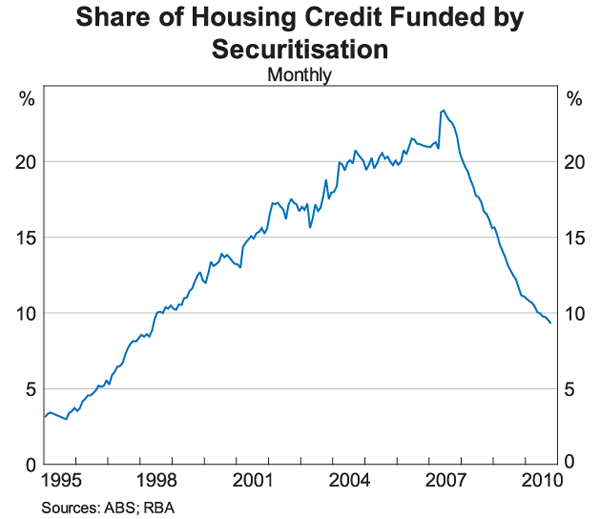
A range of factors on both the demand and supply side underpinned the rapid growth in securitisation. On the supply side, changes in technology and the fall in nominal interest rates were important in improving the competitive position of non-bank originators in the mortgage market, who tapped securitisation markets for funding because they did not have access to cheap deposit funding.
On the demand side, the dearth of supply of high quality credit instruments in the Australian market made asset-backed securities (ABS), and RMBS in particular, an attractive investment for many domestic investors. This domestic demand was the foundation of the market in the early days. Over time, the ability to tap international markets became an increasingly important source of demand for Australian RMBS, such that prior to the crisis, offshore issuance accounted for more than half of outstanding Australian RMBS (Graph 2).
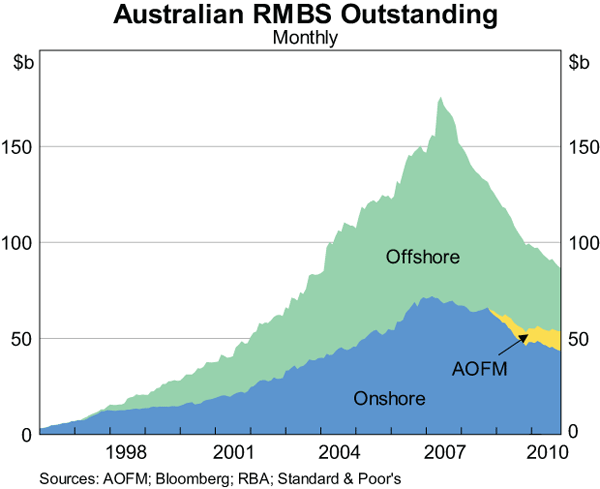
Offshore structured investment vehicles (SIVs) comprised a sizeable share of the international investor base. As is now widely known, these SIVs funded themselves short and invested in long-dated assets like RMBS, a business model that was particularly vulnerable.
The Impact of the Financial Crisis
The re-appraisal of risk brought on by the financial crisis led to demand from international investors retreating faster than domestic demand (Graph 3). The SIVs were particularly hard hit by the crisis. Their funding was severely curtailed and many of their assets turned out to be poor performing, illiquid or both. Many were forced to shut down and liquidate their portfolios, in the process selling their Australian RMBS into the secondary market, notwithstanding its good performance. Indeed, Australian RMBS was often sold first because of its good performance.
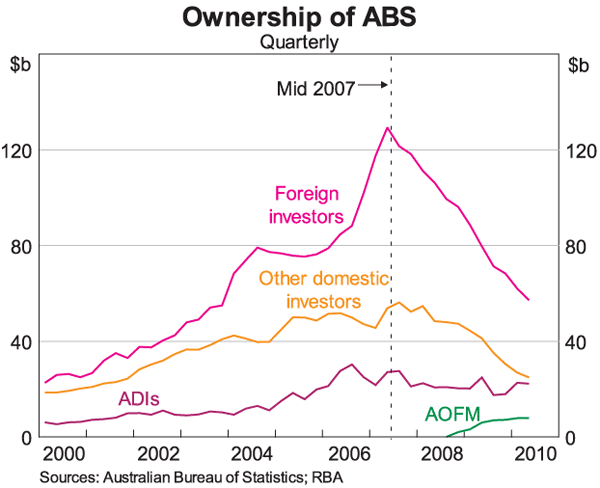
On top of this, investor demand for new issuance declined both internationally and domestically because of the brand damage to RMBS from the US in particular, where poor lending and servicing practices saw a material deterioration in collateral performance.
The liquidation by the SIVs of their RMBS holdings, combined with the increased aversion to the product from investors because of the brand damage emanating from the US, saw the price in the secondary market decline significantly. Our estimate is that, in Australia, yields on RMBS in the secondary market widened from around 20 basis points over the bank bill rate pre-crisis to as much as 450 basis points. While the secondary market spread remained this wide, there was likely to be little new primary issuance. Investors could satisfy their demand much more cheaply in the secondary market.
It is well understood that as a consequence of the demise of SIVs, the investor base for asset-backed securities is substantially narrower than prior to the crisis. This is particularly the case in offshore markets. As some of these investors relied on various forms of excessive leverage to be profitable, they are not likely to return. But there are still natural investors, both domestic and offshore, that ought to be attracted to the high quality of the Australian RMBS.
Recent Developments
RMBS issuance this year has been around $18 billion, higher than the $14 billion issued last year but well below the $50 billion plus annual issuance prior to the crisis (Graph 4). However, this comparison exaggerates the situation. The underlying pace of housing credit growth has also slowed from around 15 per cent per annum to around 7 per cent. So given this slowing in system credit growth, comparisons of gross issuance with the pre-crisis period are not very informative.
An alternative benchmark is the amount of issuance required for securitisation to hold its own as a share of total housing lending. A rough calculation suggests that annual gross issuance of around $25 to $30 billion would be required to see securitisation maintain its current share of housing credit.
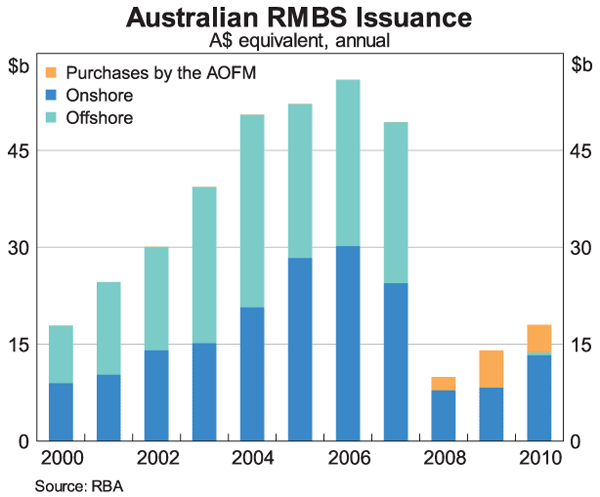
All of the issuance this year, with the exception of one tranche in early 2010, has been in the domestic market. The issuance has been mostly by the smaller lenders, regional banks, credit unions and originators, who have limited access to alternative funding sources. These issues have involved some degree of support from the AOFM. In total, only $3.2 billion of the RMBS issued have not had AOFM support.
In thinking about the AOFM support for the RMBS market, I believe the AOFM program has a number of advantages relative to alternative means of support: it can be easily tailored to help specific types of institutions; it can be phased out easily; the likelihood that the Government loses money on its investment is very small; and there is no ongoing contingent liability to the Government from providing the support. If instead a government guarantee of RMBS were provided, it would be difficult to phase out, creating a commitment that could generate a large contingent liability for the Government.
At this time last year, and into the early part of 2010, there were signs indicating that the market was developing some momentum. Issuance was on an upward trend and the share taken up by the AOFM had declined from the very high levels seen at the start of the Government's support programme (Graph 5). There were also two issues in the first part of the year that did not have AOFM support. However, conditions deteriorated in the second quarter with credit markets generally unsettled by the sovereign debt concerns in Europe.
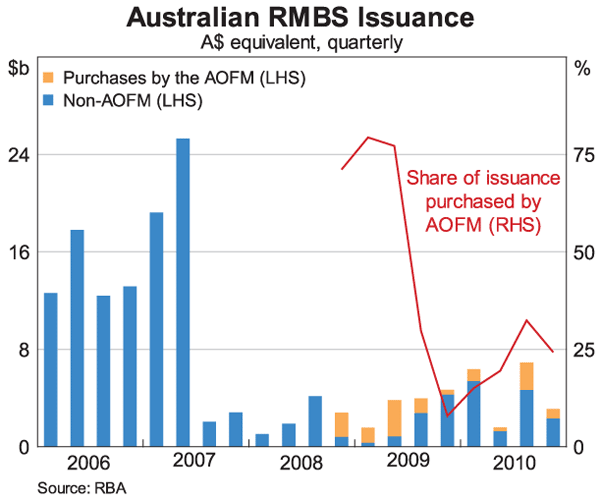
In response to these difficulties, the AOFM adjusted the pricing of its cornerstone RMBS investments in May with the express purpose of making securitisation a more competitive source of funding for small players in the mortgage market. Prior to May, private investor bids were only just within the range which made deals competitive for issuers. The AOFM started buying long-dated tranches at a spread of around 110 basis points over swap. Private investors in these deals bought the shorter-dated tranches often at a spread that was around 100 basis points. As a result, average issuance costs for senior notes declined from around 140 basis points to close to 100 basis points over swap (Graph 6).
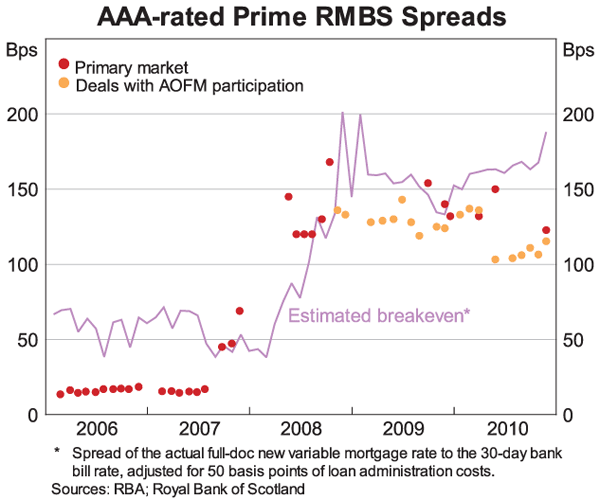
This tightening in primary market spreads has seen the volume of issuance pick up in the second half of the year. Although the AOFM has increased its share of issuance, private investors have nevertheless taken around two-thirds of the issuance since May.
There has also been a gradual lengthening in the average maturities of tranches taken up by private sector investors, and some sales of first-loss tranches. The cost of the recent Bank West deal that priced without AOFM support, and included a soft bullet structure to attract investors, also suggests some improving appetite on the part of investors.
While it is difficult to get a precise estimate of secondary market pricing, it appears to have remained broadly stable over recent quarters still much wider than prior to the crisis. The widening of RMBS spreads was generally larger than that of other funding instruments, such as unsecured bank credit, and it has not narrowed as much from the peak (Graph 7).
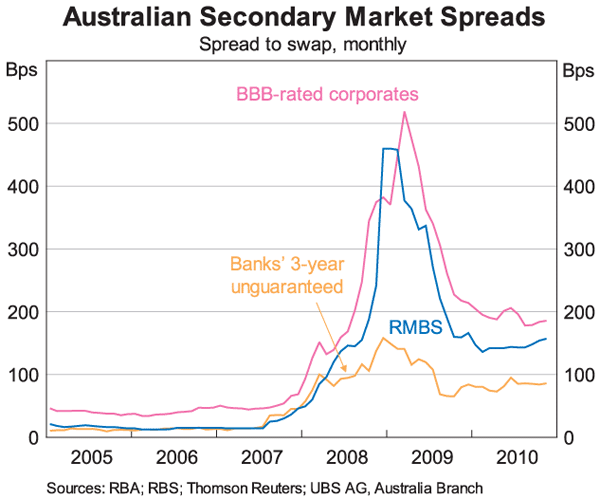
It is difficult, given the very strong historical performance of Australian mortgages that provide the underlying collateral, not to view this relative pricing as somewhat anomalous. On the other hand, it is the legacy of the brand damage the crisis inflicted on mortgage-backed securities and a measure of the work still to be done by the industry and regulators to restore investor confidence and improve liquidity.
There is, of course a good story to tell: the arrears rates on Australian mortgages have remained at a low level and are well below the arrears rates in many other countries (Graph 8).
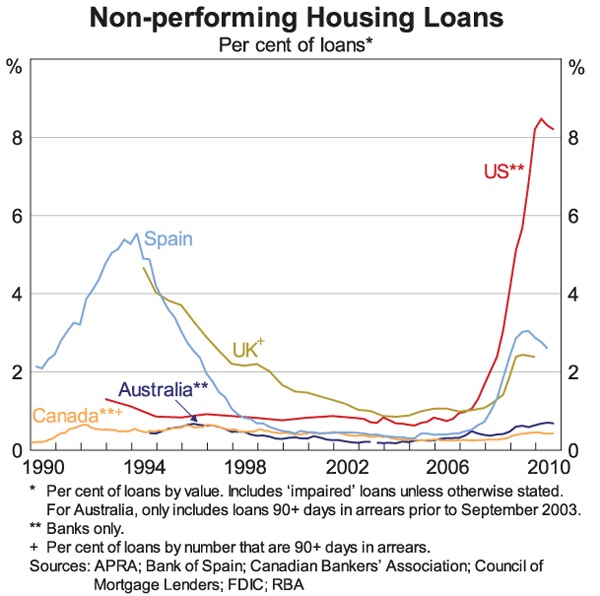
The state of the securitisation market in Australia is by no means unique, with issuance in other markets also sluggish. Credit markets globally still remain cautious, with the sovereign debt concerns in the second quarter tempering investor appetite. For example, issuance in the UK RMBS market was particularly weak in the early part of the year, but has seen a modest pick-up in activity more recently (Graph 9). One promising development has been the pick-up in offshore issuance by UK originators, exemplified by the recent Lloyds issue in the US.
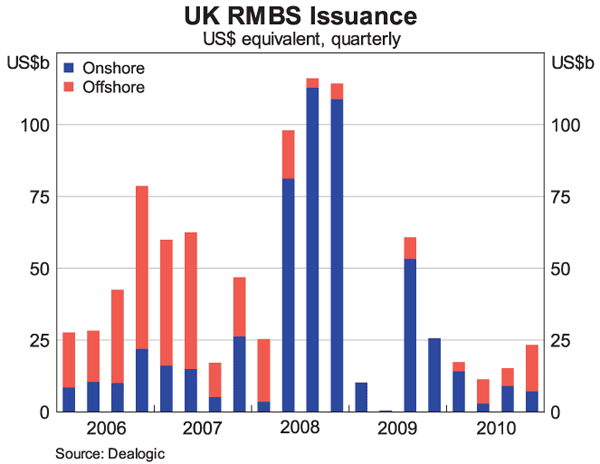
A constraint on offshore issuance more specific to the Australian market has been the influence of the cross-currency basis swap on the cost of issuing in the international market. As I noted earlier, the international market was an important source of demand for the Australian market prior to the crisis. A significant share of the issuance to offshore investors was in foreign currency, but post-crisis there has only been one issue with a foreign-currency tranche. Part of the reason for this is that the wide basis swap has added to the hedging costs of offshore issues making them less economic, compared with domestic issues.
Conclusion
In conclusion, I have aimed to provide a recap of the state of play in the Australian RMBS market. The market is slowly returning to life and I believe it will again play a useful role in the provision of credit in Australia. But I do not see it returning to its pre-crisis share of the market any time soon. I look forward to discussing the policy issues surrounding the market with my fellow panel members.
Endnote
Thanks to Patrick D'Arcy and Daniel Ji for their help. [*]
